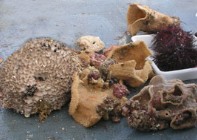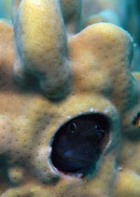Porifera collection
 Curator
Curator
Collection manager
About the collection
The collection has worldwide coverage, both in shallow waters and in the deep sea, although with large variation from one geographical region to another. It centers on the North Atlantic (Iceland, The Faroes, Scandinavia), and the Arctic (Greenland, The Greenland-, Iceland- and Norwegian Seas). Regional collection efforts have resulted also in comprehensive materials from The West Indies, West Africa, Mauritius, Indonesia, New Zealand, and Antarctica. Finally, there is a collection of freshwater sponges, mainly from Danish lakes and streams.
Much material, especially of older date, is either sorted and partly identified or still unsorted. Most samples are stored in alcohol, the rest are dried. Samples provided after 1900 are generally supposed to have been treated with formaldehyde. With the oldest samples being from the 1870’es sampling efforts have been scattered over time, and carried through on expeditions with different main objectives and using different kinds of gear. Small-sized and fragile specimens are largely missing from the collection, as materials were handled by collectors of varying professional background, rarely sponge specialists.
More than 100 publications have fully or in part been based on specimens in the collection, the oldest dating back from 1870.
Porifera collection in numbers
- Estimated number of specimens: More than 100,000 specimens, in more than 40,000 lots
- Type specimens: Approx. 500 of which approx. 300 are digitized
- Digitally available specimens: The collection is only sporadically digitized
Strengths
- The sponge fauna of Greenland
- The sponge fauna of the northern Atlantic
- Deep Sea sponges from many parts of the world ocean
Important subcollections
Especially significant with respect to size and coverage of the diversity of the investigated areas are the collections from the Danish “Ingolf” Expedition 1895-96 (especially around Iceland and southern Greenland), the “Godthaab” Expedition 1928 (Davis Strait and Baffin Bay), the “Galathea” Expedition 1950-52 (around the World), Th. Mortensen's expedition to New Zealand 1914 (part of his Pacific Expedition 1913-1916), the BIOFAR cruises around the Faroes 1987-90, and “Polarstern” expeditions in Antarctica 1989 and 1991 (The Weddell Sea).
History
The beginnings of the collection dates back to the 1870’es. Around this time a tradition was created by the then professor of zoology, Japetus Steenstrup, who contacted officials in the Danish colonies and captains of merchant vessels, asking them to provide and send home interesting specimens. During the following decennia the Zoological Museum received scattered and somewhat fortuitous materials from Greenland, Iceland, The Faroes, The Virgin Islands (Danish West Indies), The Mediterranean and East Asian waters.
More comprehensive and informative collections were provided on regular expeditions and from collection done by young naturalists liable for service on naval and Fishery Inspection vessels. Examples of Danish expeditions where such materials were provided are the “Dijmphna” Expedition 1882-83 (the Kara Sea), the “Fylla” cruises 1884 and 1886 (West Greenland), the “Ingolf” Expedition 1895-96 (deepwater around southern Greenland, Iceland and The Faroes), the “Hekla” Expedition 1898-1900 (The Carlsberg Foundation’s East Greenland Expedition), the “Danmark” Expedition to Northeast Greenland 1906-08, the “Tjalfe” cruises 1908 and 1909 (West Greenland), the “Godthaab” Expedition 1928 (West Greenland), the cruises of the project The Zoology of the Faroes 1924-27, the “Atlantide” Expedition 1945-46 (West Africa), and the “Galathea” Expedition 1950-52 (around the World).
 One very remarkable one-man contribution has resulted in accession of comprehensive materials of invertebrates, including sponges. This was accomplished by Th. Mortensen (1868-1952), inspector at the Zoological Museum, who between 1899 and 1930 travelled in many parts of the World collecting in shallow waters. Many of his materials originate from localities which for different reasons are inaccessible or difficult to visit today with the aim of collecting.
One very remarkable one-man contribution has resulted in accession of comprehensive materials of invertebrates, including sponges. This was accomplished by Th. Mortensen (1868-1952), inspector at the Zoological Museum, who between 1899 and 1930 travelled in many parts of the World collecting in shallow waters. Many of his materials originate from localities which for different reasons are inaccessible or difficult to visit today with the aim of collecting.
More recent additions to the collection are from a number of cruises around the Faroes (The BIOFAR projects), off Svalbard and East Greenland (“Meteor”, “Polarstern”) and in the Norwegian and Greenland Seas (“Håkon Mosby”), as well as from the efforts of a number of single persons off Norway (the Bergen, Trondheim and Tromsø areas), the Swedish Skagerrak coast and Maine.
Historically, the sponge collection has only part of the time been curated by sponge specialists. The earliest was G.M.R. Levinsen (1850-1914), who also took care of many other invertebrate collections and, in fact, mainly worked with polychaetes and bryozoans. The next was W. Lundbeck (1863-1941) who came to the museum in 1904. His ‘sponge-period’ lasted from the time he participated in the “Ingolf” Expedition in 1895 and 1896 and he wrote three large papers on parts of the sponges, until 1910, when he moved to the entomology department. It should be mentioned that another Danish sponge specialist, H.V. Brøndsted (1893-1977), who between 1914 and 1933 wrote on sponges from the collection, never was employed by the museum and did no curatorial work, not even label-writing. O.S. Tendal (1942-) came to the museum in 1987, curating the sponges and a number of other marine invertebrate groups until retirement 2012. The period was dominated by comprehensive sampling in the North Atlantic and other parts of the world.
